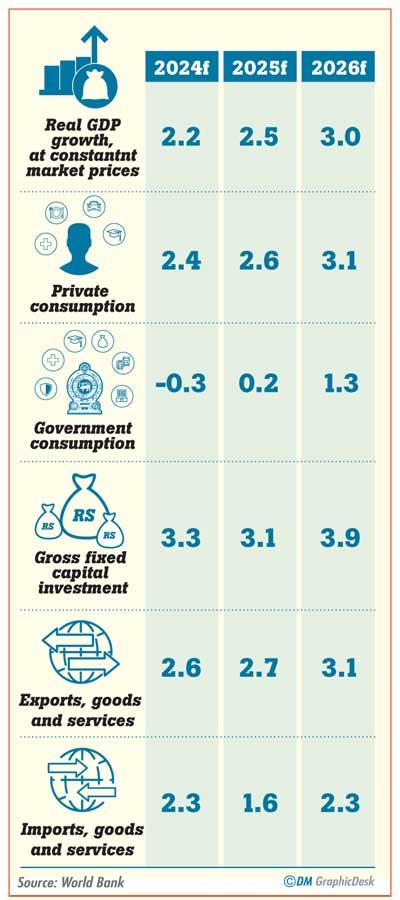03 Apr 2024 - {{hitsCtrl.values.hits}}
- Forecasts a modest pickup in growth of 2.5 percent in 2025, with a gradual increase in inflation and a small current account surplus
Sri Lanka is likely to witness a modest growth of 2.2 percent in 2024, according to World Bank projections, showing signs of stabilisation, following the severe economic downturn in 2022.
signs of stabilisation, following the severe economic downturn in 2022.
“Sri Lanka’s economy is on the road to recovery, but sustained efforts to mitigate the impact of the economic crisis on the poor and vulnerable are critical, alongside a continuation of the path of robust and credible structural reforms,” said World Bank Country Director for Maldives, Nepal and Sri Lanka Faris Hadad-Zervos in a statement.
The report projects a modest pickup in growth of 2.5 percent in 2025, with a gradual increase in inflation and a small current account surplus.
However, high debt service obligations are expected to exert pressure on fiscal balances. Poverty rates are anticipated to remain above 22 percent until 2026. Risks to the outlook remain, particularly in relation to inadequate debt restructuring, reversal of reforms, financial sector vulnerabilities, and the enduring impact of the crisis.
The report emphasises that strong reform implementation will be fundamental to fostering a resilient economy through continued macro-fiscal-financial stability, greater private sector investment, and addressing risks associated with state-owned enterprises.
However, the island nation has much to do in addressing its elevated poverty levels, income inequality, and labour market concerns, the World Bank said in its latest bi-annual report - ‘Sri Lanka Development Update: Bridges to Recovery’.
The report highlighted that Sri Lanka saw declining inflation, higher revenues on the back of the implementation of new fiscal policies, and a current account surplus for the first time in nearly five decades, buoyed by increased remittances and a rebound in tourism.
However, poverty rates continued to rise for the fourth year in a row, with an estimated 25.9 percent of Sri Lankans living below the poverty line in 2023.
Labour force participation has also seen a decline, particularly among women and in urban areas, exacerbated by the closure of micro, small, and medium-sized enterprises (MSMEs).
Households are grappling with multiple pressures from high prices, income losses, and under employment. This has led to households taking on loans to meet food requirements and maintain spending on health and education.
28 Nov 2024 12 minute ago
28 Nov 2024 32 minute ago
28 Nov 2024 2 hours ago
28 Nov 2024 3 hours ago
28 Nov 2024 3 hours ago